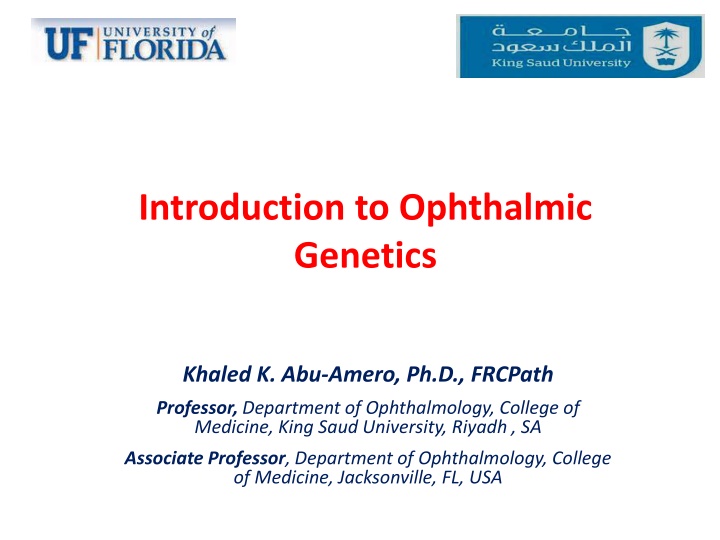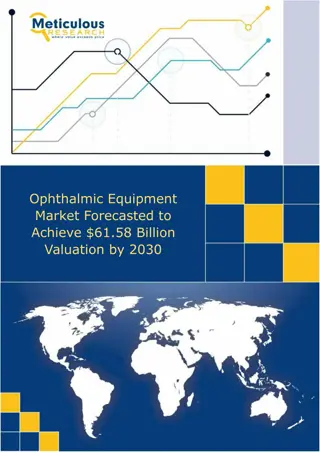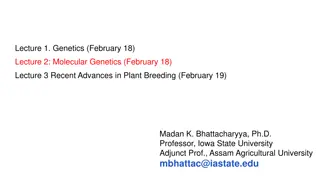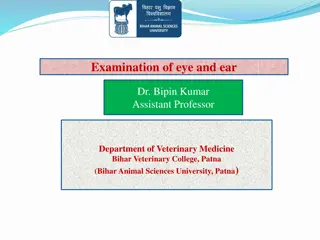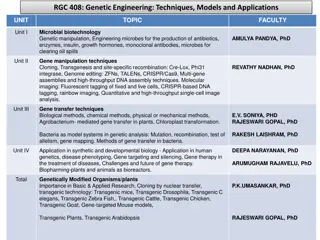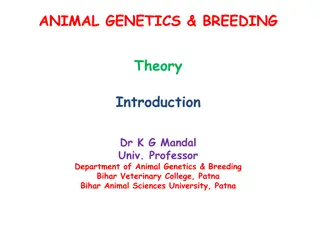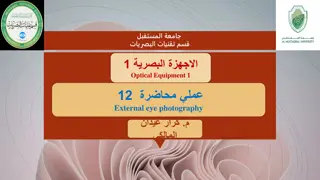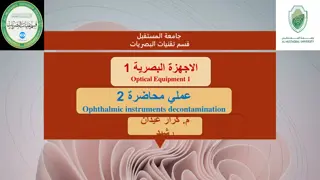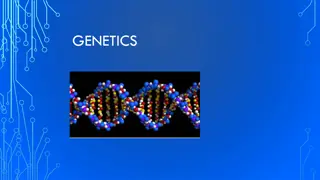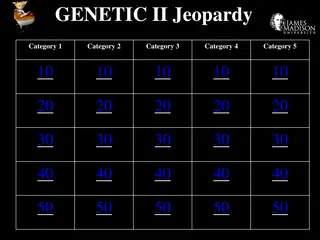Importance of Ophthalmic Genetics in Clinical Practice
Ophthalmologists play a critical role in diagnosing, managing, and providing genetic counseling for patients with genetic eye disorders. Understanding inheritance patterns, recognizing genetic basis of diseases, and knowing about Mendelian disorders are essential for effective patient care and counseling.
Download Presentation

Please find below an Image/Link to download the presentation.
The content on the website is provided AS IS for your information and personal use only. It may not be sold, licensed, or shared on other websites without obtaining consent from the author.If you encounter any issues during the download, it is possible that the publisher has removed the file from their server.
You are allowed to download the files provided on this website for personal or commercial use, subject to the condition that they are used lawfully. All files are the property of their respective owners.
The content on the website is provided AS IS for your information and personal use only. It may not be sold, licensed, or shared on other websites without obtaining consent from the author.
E N D
Presentation Transcript
Introduction to Ophthalmic Genetics Khaled K. Abu-Amero, Ph.D., FRCPath Professor, Department of Ophthalmology, College of Medicine, King Saud University, Riyadh , SA Associate Professor, Department of Ophthalmology, College of Medicine, Jacksonville, FL, USA
Why Ophthalmologists need to know about Genetics Almost 50% of paediatric blindness is due to a genetic aetiology. The eye is second only to the brain as an individual organ in its frequency of involvement in genetic disorders. The ophthalmologist plays important roles not only in clinical diagnosis and management but may also be asked by patients and their families to provide genetic counselling and referrals to appropriate subspecialty services. An understanding of clinical genetic concepts and accurate diagnosis are prerequisites for effective genetic counselling. Examination of other family members might be required.
How to Recognize a Disease with a Genetic Basis? Family History Previous studies had linked the disease to a gene(s) Chromosomal abnormalities are largely sporadic No family History Trauma with no family history may be NO GENETICS BASIS Gene-Environment Interaction
Inheritance patterns Mendelian disorders are caused by mutations in single genes and follow the principles of inheritance initially described by Gregor Mendel in 1866. 5 types of mode of inheritance follow Mednel One type (mitochondrial inheritance does not follow Mendel).
Autosomal Dominant An affected person usually has at least one affected parent Affects either sex A child of affected X unaffected mating has 50% chance of being affected Retinoblastoma, Retinitis pigmentosa
Autosomal Recessive Males & females affected in equal proportions Individuals affected in single sibship in one generation (horizontal transmission) Consanguinity provides further support of AR inheritance Cystic fibrosis Sickle cell disease Thalassaemia Haemochromatosis
X-Linked Recessive Males affected almost exclusively Transmitted through carrier females to sons (knight s move pattern) Affected males cannot transmit disorder to sons Duchenne & Becker muscular dystrophy Haemophilia Fragile X Syndrome
X-linked dominant Affect either sex The child of an affected female has a 50% chance of being affected For an affected male, all his daughters will be affected and none of his sons will be affected. Rett syndrome, incontinentia pigmenti
Y-linked Inheritance Because males inherit a Y chromosome from their fathers, every son of an affected father will be affected. Because females inherit an X chromosome from their fathers, female offspring of affected fathers are never affected.
Mitochondrial Inheritance Transmit only from the mother Males and Females of an affected mother have equal chances of getting the disease (each 50%). Mitochondrial diseases are usually multi- systemic. LHON, MELAS, Chronic Progressive External Ophthalmoplegia (CPEO)
Sequence Changes and Diseases Causative Disease + Environmental AA factors Mutation Change Non- Causative Risk Factor Sequence Change No AA change Polymorphism
Retinitis Pigmentosa (RP) Parameter Description Clinical features Affects Retina, loss of night vision (peripheral vision) Age of onset Childhood Genetic cause Mutations in various genes (Causative) Mode of Inheritance Autosomal dominant, Autosomal recessive, X-linked # of Genes > 60 genes Frequency in population Secondary Causes 1 in 3,500 to 1 in 4,000 people (USA and Europe) Syndromic RP - usher syndrome (combination of vision loss and hearing loss)- Bardet-Biedl syndrome; Refsum disease; and neuropathy, ataxia, and retinitis pigmentosa (NARP) Available commercially Genetic testing
Primary Angle Closure Glaucoma (PACG) Parameter Description Clinical features Narrow iridocorneal angle resulting in a blockage of the aqueous outflow structures. Sight loss if not treated Mean 52.9 18.8 Age of onset Genetic cause SNPs and mutations (risk factors) Mode of Inheritance Not determined but mainly AD in cases where mode of inheritance can be determined rs11024102 in PLEKHA7 rs3753841 in COL11A1 rs1015213 (PCMTD1 and ST18 on chromosome 8q) 1 of 1000 whites / about 1 in 100 Asians / 2-4 of 100 Eskimos / Saudi Arabia, 40% of glaucoma are PACG Research based only # of Genes Frequency in population Genetic testing
Primary Open Angle Glaucoma (POAG) Parameter Description Clinical features Open anterior chamber angles, visual field abnormalities, High IOP and optic nerve damage with a loss of optic nerve fibers Adulthood Mutations (OPTN, MYOC in <5% of patients) Genetic risk factors(multiple SNPs) Age of onset Genetic cause Mode of Inheritance Complex Mendelian forms are autosomal dominant. A positive family history is a strong risk factor for this disease up to 50% of patients with POAG have family history of this disorder MYOC, OPTN, and SNPs risk factors CAV1/CAV2, TMCO1, CDKN2B-AS1, CDC7-TGFBR3, SIX1/SIX6, GAS7 and ATOH7 Affects around 2% of adult population # of Genes Frequency in population Genetic testing Available commercially
Keratoconus Parameter Description Clinical features Degenerative disorder of the eye in which structural changes within the cornea cause it to thin and change to a more conical shape than the more normal gradual curve. The mean age of onset 39.3 years Age of onset Genetic cause VSX1 gene (< 5% of cases had mutation) Mode of Inheritance Mainly Sporadic, can be familial (some cases are Autosomal recessive) # of Genes 20 genes 8-10 SNPs (genetic risk factors) Frequency in population Prevalence range from 1 in 500 to 1 in 2000 people - in the Middle East (including the Arabs and non-Arabs) the incidence is between 20/100,000 and 24.9/100,000 Commercially available Genetic testing
Primary Congenital Glaucoma (PCG) Parameter Description Clinical features Epiphora, photophobia and blepharospasm are the three most common manifestations. Untreated PCG is a major cause of childhood blindness Children from birth to age 3 Age of onset Genetic cause CYP1B1 (Causative) Mode of Inheritance Mainly autosomal recessive Sporadic cases has been reported # of Genes One gene CYP1B1 Frequency in population Genetic testing It affects about one in every 10,000 infants. Higher is societies were consanguinities are prevalent Commercially available
Optic Neuritis Parameter Description Clinical features Inflammation and deterioration of optic disk - loss of vision in one eye that may occur within several hours of onset. The severity ranging from slight visual deficiency to complete loss of light perception. reduction in color perception. associated with MS female between the ages of 18 and 45 you ve been diagnosed with multiple sclerosis (MS) Age of onset Genetic cause Not Known some mtDNA mutation been reported in some cases of ON Secondary Causes Mumps, measles, tuberculosis, Lyme disease # of Genes 0 Frequency in population Genetic testing Overall in North America, the incidence of optic neuritis is about 3 per 100,000 people per year n/a
Retinoblastoma Description Parameter Clinical features The most common presentations are leukocoria and strabismus.. Tumors may spread towards the vitreous cavity (endophytic spread) or towards the outer layers of the eye and subretinal space (exophytic tumor). Age of onset Mean age of onset for bilateral cases is 15 months and for unilateral cases 24 months. Genetic cause Retinoblastoma (RB1) gene (causative) Mode of Inheritance Autosomal dominant. # of Genes One gene Frequency in population Incidence of 4:1,000,000 or about 1:23,000 live births. Genetic testing Commercially available
Ocular Motility Congenital Fibrosis of Extarocular Muscles (CFEM) Neurological Involvement Congenital Cranial Dysinnervation Disorders(CFEM) Duane Retraction Syndrome
Genetics of DRS DRS syndrome Gene(s) Characteristics DURS1 Cytogenetic abnormalities on Chr. 8q13 Contiguous gene deletion syndrome DURS2 CHN1, important in CN6 and CN3 axon path finding Often bilateral with vertical motility abnormalities DRRS, Duane Radial Ray Syndrome SALL4, important in patterning of embryonic CN6, limbs, and heart Variable hand and upper extremity anomalies; variable cardiac, renal, auditory, and vertebral abnormalities
